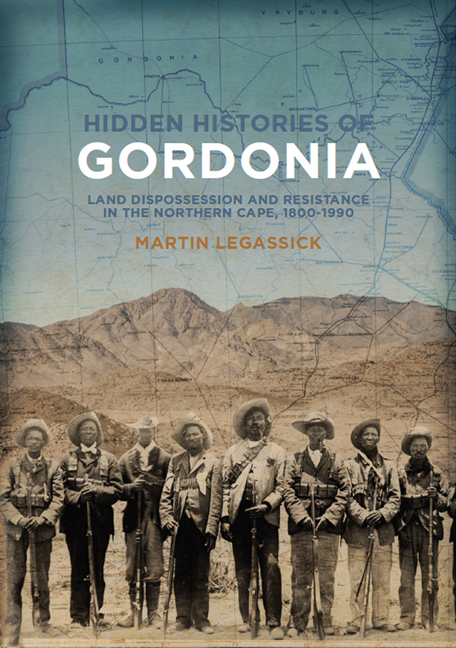Book contents
- Frontmatter
- Dedication
- Contents
- Acknowledgements
- Acronyms and abbreviations
- Illustrations
- Preface
- Chapter 1 The prehistory of Gordonia
- Chapter 2 The Baster settlement of Gordonia and its decline
- Chapter 3 The will of Abraham and Elizabeth September: a struggle for land in Gordonia, 1898–2014
- Chapter 4 From prisoners to exhibits: representations of Bushmen of the northern Cape, 1880–1900
- Chapter 5 South African human remains and the politics of repatriation: reconsidering the legacy of Rudolf Pöch
- Chapter 6 The early history of the brown Afrikaners in Riemvasmaak
- Chapter 7 The battle of Naroegas
- Chapter 8 The Marengo rebellion and Riemvasmaak, 1903–1907
- Chapter 9 The racial division of Gordonia, 1921–1930
- Chapter 10 Keidebees and Blikkies locations, Upington, 1894–1974
- Chapter 11 ‘All my powers have been swallowed by Upington’: the life and times of Alfred Gubula
- References
- Index
Chapter 10 - Keidebees and Blikkies locations, Upington, 1894–1974
Published online by Cambridge University Press: 20 April 2018
- Frontmatter
- Dedication
- Contents
- Acknowledgements
- Acronyms and abbreviations
- Illustrations
- Preface
- Chapter 1 The prehistory of Gordonia
- Chapter 2 The Baster settlement of Gordonia and its decline
- Chapter 3 The will of Abraham and Elizabeth September: a struggle for land in Gordonia, 1898–2014
- Chapter 4 From prisoners to exhibits: representations of Bushmen of the northern Cape, 1880–1900
- Chapter 5 South African human remains and the politics of repatriation: reconsidering the legacy of Rudolf Pöch
- Chapter 6 The early history of the brown Afrikaners in Riemvasmaak
- Chapter 7 The battle of Naroegas
- Chapter 8 The Marengo rebellion and Riemvasmaak, 1903–1907
- Chapter 9 The racial division of Gordonia, 1921–1930
- Chapter 10 Keidebees and Blikkies locations, Upington, 1894–1974
- Chapter 11 ‘All my powers have been swallowed by Upington’: the life and times of Alfred Gubula
- References
- Index
Summary
The previous chapters have examined segregation, forced removals, and resistance in the rural areas of Gordonia and vicinity. This chapter turns to an examination of the establishment of urban locations in Upington and eventual forced removal from them. The research on which the chapter is based was initially undertaken for the Commission on Restitution of Land Rights, forming the historical section of a report on the basis of which 688 land claimants from the two locations of Blikkies and Keidebees received R18.7 million in a restitution settlement. The forced removals from these locations took place in the 1960s. The schemes on which these moves were based dated from the 1940s, even before the accession of the NP to government. The chapter starts, however, with the pre- 1940s historical background to three locations in Upington. Figure 10.1 depicts the growth of Upington during the period covered by this chapter.
The origins of the first Upington location are unknown: the first mention of it is in 1890. By October 1910 it was estimated to have 135 huts – made mainly of ‘mud and straw’ – and a population of 125 men and 375 women. There is, however, evidence on the foundation of Keidebees. The town's Village Management Board (VMB) was told in May 1894 that 50 people (‘squatters’) were living on the Upington commonage and had refused to move to the existing (Upington) ‘Location’. It was pointed out by two Basters on the VMB that the people concerned were servants who would be too far from their masters if they moved there. The VMB then agreed that ‘a second Location at Keidebees be Established for the Convenience of the Residents; and that a Commission… be appointed to beacon off the two Locations providing the separation of the different classes’.
From at least 1903 onwards, location residents were time and again subjected to the insecurity of threats to move or destroy the locations, in particular Upington location. In October 1926 the town council decided to have the Upington and Keidebees locations proclaimed under the Native (Urban Areas) Act No. 21 of 1923 and this was done in the Government Gazette of 25 March 1927.
- Type
- Chapter
- Information
- Hidden Histories of GordoniaLand dispossession and resistance in the Northern Cape, 1800–1990, pp. 317 - 342Publisher: Wits University PressPrint publication year: 2016



